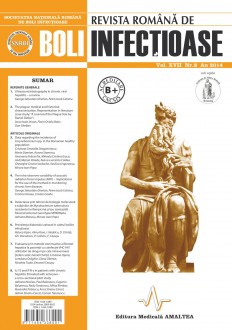SELECT ISSUE

Indexed

| |

|
|
|
| |
|
|
|

|
|
|
|
|
|
| |
|
|
HIGHLIGHTS
National Awards “Science and Research”
NEW! RJID has announced the annually National Award for "Science and Research" for the best scientific articles published throughout the year in the official journal.
Read the Recommendations for the Conduct, Reporting, Editing, and Publication of Scholarly work in Medical Journals.
The published medical research literature is a global public good. Medical journal editors have a social responsibility to promote global health by publishing, whenever possible, research that furthers health worldwide.
THE INTRA-OBSERVER VARIABILITY OF ACOUSTIC RADIATION FORCE IMPULSE (ARFI) – IMPLICATIONS FOR THE USE OF THE METHOD IN MONITORING CHRONIC LIVER DISEASES
George Sebastian Gherlan, Petre Iacob Calistru, Cristina Voinea and Cristian Szabo
ABSTRACT
Introduction and aims. Liver fibrosis is reversible if the cause is removed or it may progress otherwise. Noninvasive methods tend to replace liver biopsy for the assessment of liver fibrosis. There is an intra-observer variability for ARFI that has to be taken into account when this method is used for monitoring the evolution of a liver disease. We aimed to identify the level of variation between two ARFI results that reflects a real change in liver histology rather than this “normal” variability. Patients and methods. Two sets of 10 ARFI measurements were performed in 147 patients by the same observer and we computed the median and the interquartile range for each set. We assessed the variation between the two results as percentage of each result. Data regarding weight, height, age, etiology, biochemical and hematological test were collected. Results. The mean variation was of 9.84% ± 9.7%. The variability is reduced if we use IQR for validation (valid if IQR < 1/3 of the result), with a variation of 7.66% ± 7.09% in the group with both measurements valid versus 16.33% ± 13.03% in the group with at least one set invalid. ARFI was feasible in all patients ant we found an intra-observer intraclass correlation coefficient of 0.976. Conclusions. Only results with over 19.5% variation in plus or minus compared to a previous result should be considered to reflect the progression respectively regression of liver fibrosis. If IQR is used as a validation parameter, the variability is less than 15%.
Keywords: ARFI, intra-observer, hepatitis, liver fibrosis, monitoring, variability
